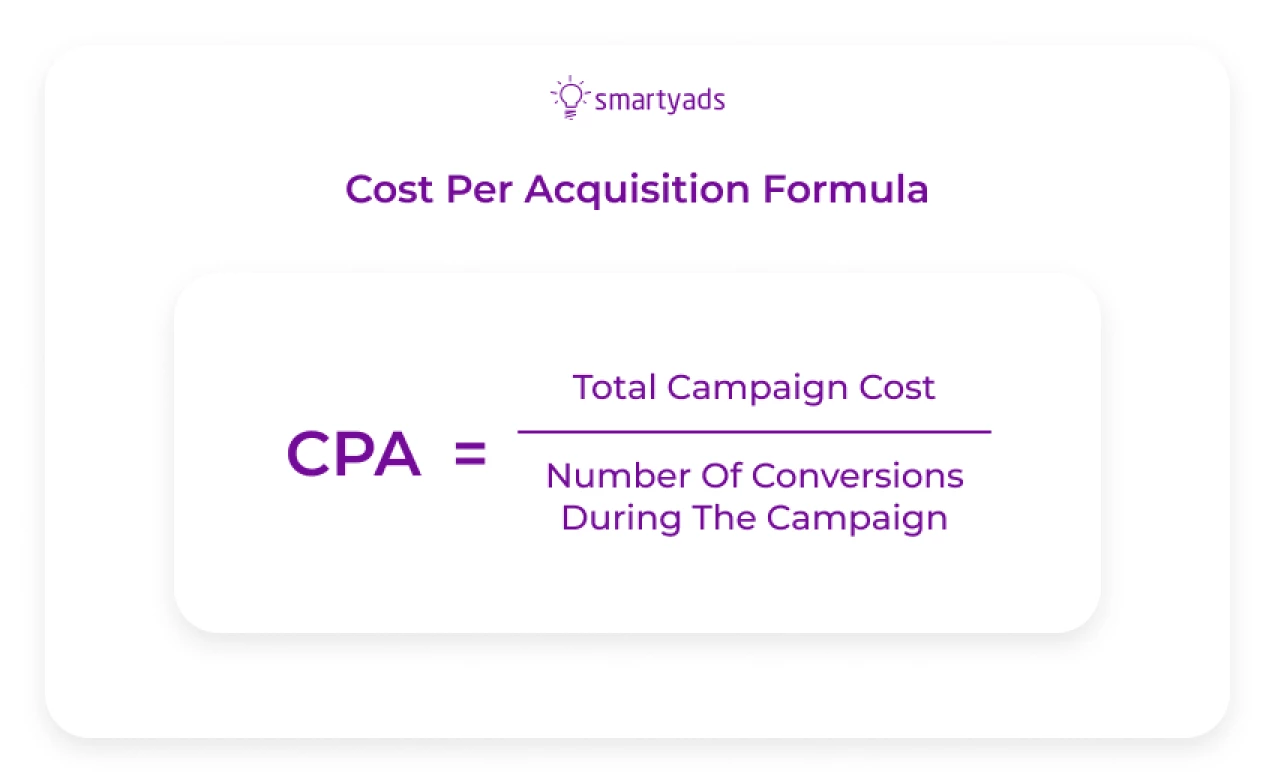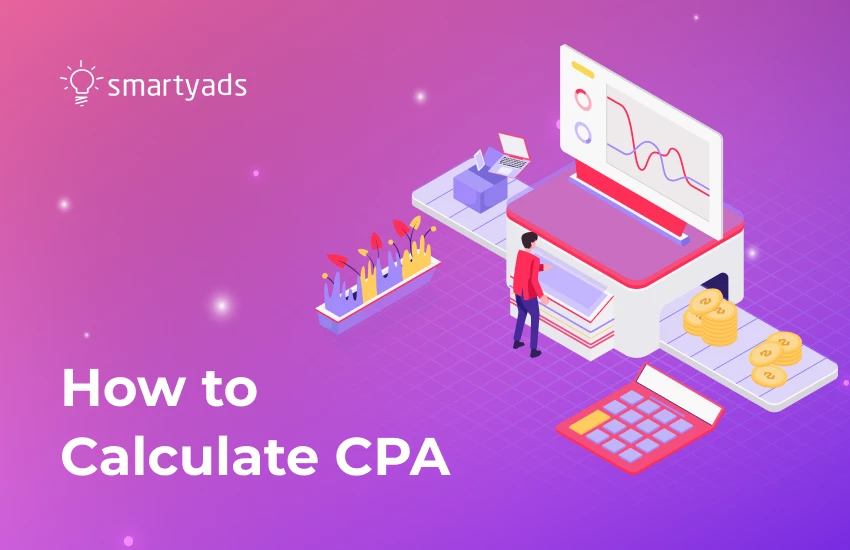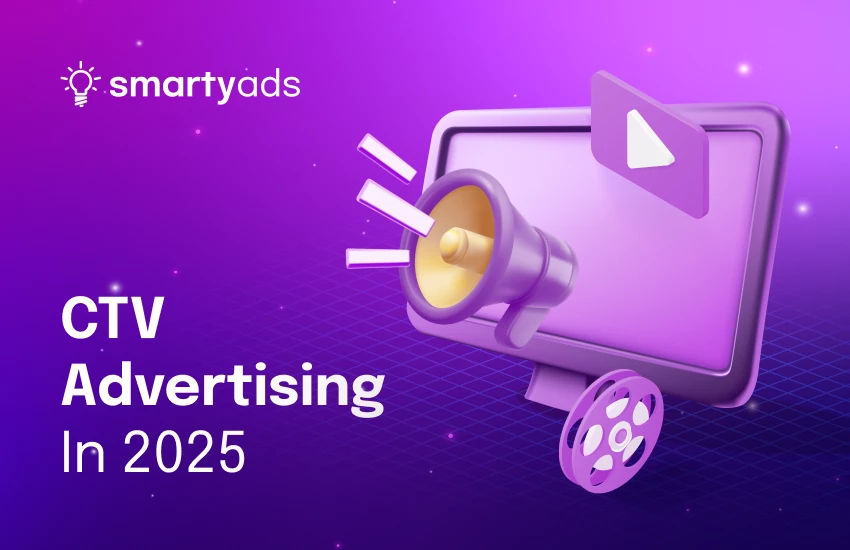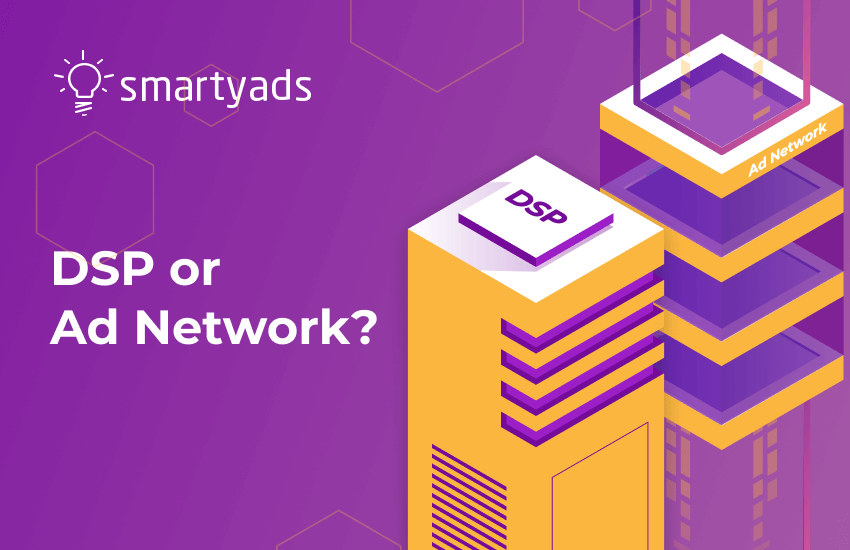There are so many ways to measure the success of your digital ad campaign. However, CPA or cost per acquisition, better than any other metric, can tell you if your efforts were effective, engaging, and successful. This blog post contains a treasure trove of valuable insights on CPA that will fully transform your advertising game.
In this article, we are going to delve into the definition and intricacies of CPA calculation, the importance of this metric for digital marketing and advertising, and so much more. Buckle up, and let’s go!

What is CPA?
Before we proceed with the CPA formula in digital marketing, let’s find out what exactly CPA is.
Cost per acquisition, or simply CPA, is a pricing model widely used in online marketing and advertising. It implies that an advertiser/marketer pays a fixed amount of money every time a user completes a predefined action, such as registration or purchase, after interacting with an advertisement.
It’s a proven way to effectively measure the performance of your ad campaigns, so now it’s time to see how to calculate cost per acquisition.
How to calculate CPA in digital marketing
Importance of CPA for your marketing and advertising campaign
This metric is increasingly popular among marketers and advertisers as it’s very cost-effective, meaning you only need to pay for the actionable results rather than waste the budget on mere ad views that are not proven to convert.
Therefore, it’s a great option for those who have a limited budget and want to achieve tangible results without overspending. As conversions are something every digital professional strives for, CPA makes it a perfect metric to evaluate the success of campaigns and make informed decisions and respective adjustments if needed.
Calculating CPA: formula
In order to understand the average cost per acquisition, you should divide the total cost of your campaign by the number of acquisitions (meaning actions or conversions) over the duration of the campaign.
Therefore, the CPA formula is very simple and straightforward:

This CPA equation can be very helpful when measuring the success of your campaign. The final number will demonstrate whether you are doing things right or if your digital campaign still needs some amendments.
Good CPA vs. bad CPA
Now that you know how to calculate CPA, let’s see what a good and a bad CPA is so you can timely adjust your campaign if needed. Of course, it’s very subjective and depends from case to case. However, as a general rule, your campaign should be profitable. Therefore, the CPA must be lower than the average revenue per user. Respectively, if your CPA exceeds the average revenue per user, it means that you are doing something wrong, and you should reconsider your campaign.
Advanced metrics beyond CPA
In order to ensure the maximum effectiveness of your marketing and advertising efforts, it’s crucial not only to calculate cost per acquisition. It’s also highly recommended to pay close attention to other interconnected metrics that can offer you even more deep and data-driven insights to get a holistic view of your performance.
- ROAS (return on ad spend). This is a very self-explanatory yet very important metric. It means the total amount of revenue generated by every penny allocated to the campaign. It has a very similar principle to ROI (return on investment). This metric can also help you measure the success of your advertising campaigns or the overall strategy. In order to calculate ROAS, you should divide the total revenue generated through the ad campaign by the final campaign cost. It will give you very quantitative measurements, and you will see if you are moving in the right direction. The same as CPA, the return on ad spend needs to be higher than the cost of the campaign to be considered successful.
- CAC (customer acquisition cost). Basically, this KPI implies the amount of money a company invests to acquire a paying customer. This is a crucial metric to determine the profitability of a business as well as its sales efficiency. It’s very easy to calculate: divide the general marketing or advertising budget by the total number of paying customers acquired. Whereas the CPA or ROAS can be used to evaluate the effectiveness of one specific campaign, CAC is used to calculate the overall profitability of your efforts and see how much it costs to attract one customer.
- CLV (customer lifetime value). Another metric we recommend you channel your attention to is CLV, as it represents the whole worth that a customer brings to a business during their relationship with a company or brand. It will enable you to calculate the total revenue generated by a specific customer. There are two types of measuring CLV — historical and predictive. Whereas the first one shows how much an existing customer has already spent, the second one indicates how much customers could spend on your products or services.
As you can see, all these metrics complement CPA and will help you holistically evaluate your marketing or advertising strategy. It’s better to make well-informed business decisions and take actionable steps to improve your efforts rather than relying on only one single metric that can not fully represent the real effectiveness of the approach you have. In the highly competitive digital landscape, it’s paramount to act fast and improve continuously in order to stay ahead of the curve.

Real-life case studies
As you know more about CPA, cost per acquisition formula, and other very important metrics, we are ready to introduce you to some real-life examples that showcase how worldwide companies have improved their CPA strategies and generated great business results.
The first example is the innovative approach of Airbnb. Although it’s pretty hard to regulate the final price of CPA, they managed to come up with an idea that helped them improve their performance by introducing referral marketing. They incentivized their existing users to refer their platform to friends and families in exchange for discounts on future bookings. As a result of this tactic, they reduced their CPA as they leveraged the power of their existing users to acquire new ones with no additional effort. This way, the company lowered its CPA while driving exponential user growth.
Another example that shows how you can optimize your CPA KPI strategy and achieve tangible results is based on the experience of Hubspot. The digital professionals at Hubspot optimized their CPA by introducing additional inbound marketing tactics. It’s a well-known fact that they offer plenty of educational resources with free access to attract potential clients and generate more leads. Once their user engages with this free content or, for instance, signs up for a free trial product version, Hubspot’s team nurtures leads and tries to convert them into paying customers. They focus their efforts on giving value to their user through relevant and free content. This strategy results in a reduced CPA and an increased number of leads who have very high chances of becoming customers.
Each of these examples shows that it’s possible to leverage innovative marketing and advertising techniques to optimize CPA no matter what the industry is.
When the question “How is CPA calculated?” becomes irrelevant and you are aware of the possibilities to optimize your KPIs, it’s time to implement these strategies for your business.
By continuously testing and refining your strategy and making the most out of data-driven insights, you will also be able to achieve substantial improvements in your CPA metrics while nurturing growth and profitability.
.webp)
How SmartyAds can help you achieve your business goals
If you are wondering how to reinforce your marketing and advertising strategy while driving revenue and boosting engagement, SmartyAds has some solid expertise to offer. We are a team of dedicated professionals in the realm of digital advertising who have a feature-rich DSP (demand-side platform) to effectively launch, track, and optimize advertising campaigns. More and more businesses of different sizes and scales have already tried our solution and opened new opportunities for growth.
With a single-view dashboard and clear and intuitive interface, you can immediately launch your next advertising campaign. By leveraging our diversity of ad formats and advanced targeting options, you will be able to reach the right audience with no effort.
We encourage you to get familiar with our latest case study that demonstrates the high impact of SmartyAds DSP on a private mobile developer. This collaboration maximized user acquisition and conversion rates broadening the business horizons of our client.
Feel free to get in touch with us, and our specialists will give you more information regarding the immense potential of our DSP platform that will fully transform your marketing and advertising strategy. You are one step away from driving bigger revenue, effectively engaging with the target audience, and increasing conversion rates while driving substantial business growth.
Get started with our innovative DSP now and drive more conversions right away!





